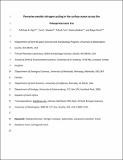Files in this item
Pervasive aerobic nitrogen cycling in the surface ocean across the Paleoproterozoic Era
Item metadata
| dc.contributor.author | Kipp, Michael A. | |
| dc.contributor.author | Stüeken, Eva E. | |
| dc.contributor.author | Yun, Misuk | |
| dc.contributor.author | Bekker, Andrey | |
| dc.contributor.author | Buick, Roger | |
| dc.date.accessioned | 2019-08-16T23:42:35Z | |
| dc.date.available | 2019-08-16T23:42:35Z | |
| dc.date.issued | 2018-10-15 | |
| dc.identifier | 255480700 | |
| dc.identifier | a402203b-d6da-45f4-8c37-b89c91a10d4f | |
| dc.identifier | 85051625682 | |
| dc.identifier | 000445718700012 | |
| dc.identifier.citation | Kipp , M A , Stüeken , E E , Yun , M , Bekker , A & Buick , R 2018 , ' Pervasive aerobic nitrogen cycling in the surface ocean across the Paleoproterozoic Era ' , Earth and Planetary Science Letters , vol. 500 , pp. 117-126 . https://doi.org/10.1016/j.epsl.2018.08.007 | en |
| dc.identifier.issn | 0012-821X | |
| dc.identifier.other | RIS: urn:E32DB2B2C271D0DE5AAAAA1530AE7D8B | |
| dc.identifier.other | ORCID: /0000-0001-6861-2490/work/65014409 | |
| dc.identifier.uri | https://hdl.handle.net/10023/18329 | |
| dc.description | MAK acknowledges support from NSF Graduate Research Fellowship DGE-1256082. AB acknowledges funding from NSERC Discovery and Accelerator grants. Funding for isotopic analyses was provided by the UW Department of Earth & Space Sciences to MAK and by NASA Exobiology grant NNX16AI37G to RB. | en |
| dc.description.abstract | Nitrogen isotope ratios in marine sedimentary rocks have become a widely used biogeochemical proxy that records information about nutrient cycling and redox conditions in Earth's distant past. While the past two decades have seen considerable progress in our understanding of the Precambrian sedimentary nitrogen isotope record, it is still compromised by substantial temporal gaps. Furthermore, quantitative links between nitrogen isotope data, marine redox conditions, and nutrient availability are largely lacking in a Precambrian context. Here we present new nitrogen isotope data from a suite of marine sedimentary rocks with ca. 2.4 to 1.8 Ga ages, spanning the Great Oxidation Event in the Paleoproterozoic, to better constrain the response of the nitrogen cycle to the first major redox transition in Earth's history. We further construct a simple box model to describe the major pathways that influenced the nitrogen isotope mass balance of the Precambrian ocean and use this as a platform to evaluate the Precambrian nitrogen isotope record. Within this framework, we find that consistently positive nitrogen isotope values, ranging from +1.1 to +7.7‰, across the early Paleoproterozoic are strong evidence for an expansion of oxygenated surface waters. Since the isotopic signature of aerobic nitrogen cycling is recorded in the biomass of nitrate-assimilating organisms, this implicates widespread nitrate bioavailability in this time interval. The decline in offshore nitrogen isotope ratios in the Mesoproterozoic is consistent with the contraction of oxic waters, which could have inhibited the expansion of nitrate-fueled ecosystems to pelagic waters until the widespread oxygenation of the ocean in the latest Neoproterozoic to early Phanerozoic. | |
| dc.format.extent | 10 | |
| dc.format.extent | 2385752 | |
| dc.language.iso | eng | |
| dc.relation.ispartof | Earth and Planetary Science Letters | en |
| dc.subject | Paleoproterozoic | en |
| dc.subject | Nitrogen isotopes | en |
| dc.subject | Paleoredox | en |
| dc.subject | Eukaryote evolution | en |
| dc.subject | Great Oxidation Event | en |
| dc.subject | Lomagundi Event | en |
| dc.subject | QE Geology | en |
| dc.subject | DAS | en |
| dc.subject | SDG 14 - Life Below Water | en |
| dc.subject.lcc | QE | en |
| dc.title | Pervasive aerobic nitrogen cycling in the surface ocean across the Paleoproterozoic Era | en |
| dc.type | Journal article | en |
| dc.contributor.institution | University of St Andrews. School of Earth & Environmental Sciences | en |
| dc.contributor.institution | University of St Andrews. St Andrews Centre for Exoplanet Science | en |
| dc.identifier.doi | 10.1016/j.epsl.2018.08.007 | |
| dc.description.status | Peer reviewed | en |
| dc.date.embargoedUntil | 2019-08-17 |
This item appears in the following Collection(s)
Items in the St Andrews Research Repository are protected by copyright, with all rights reserved, unless otherwise indicated.

